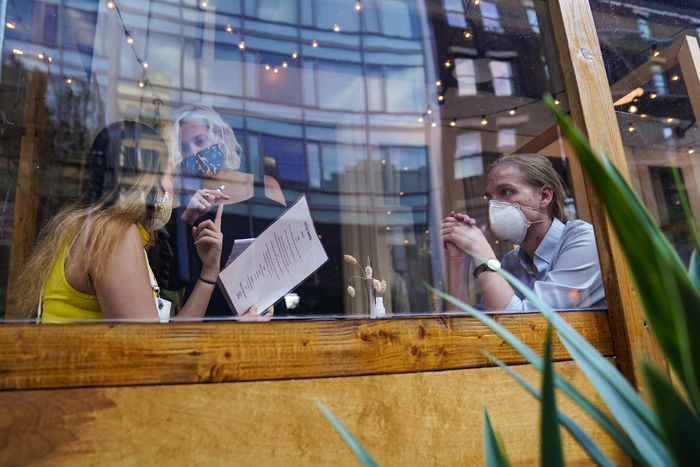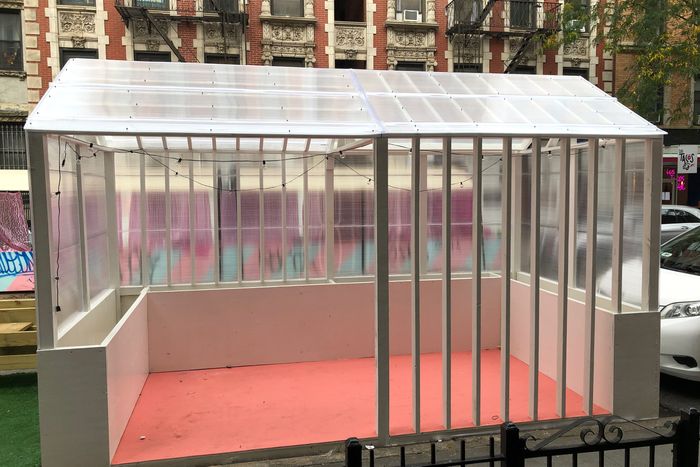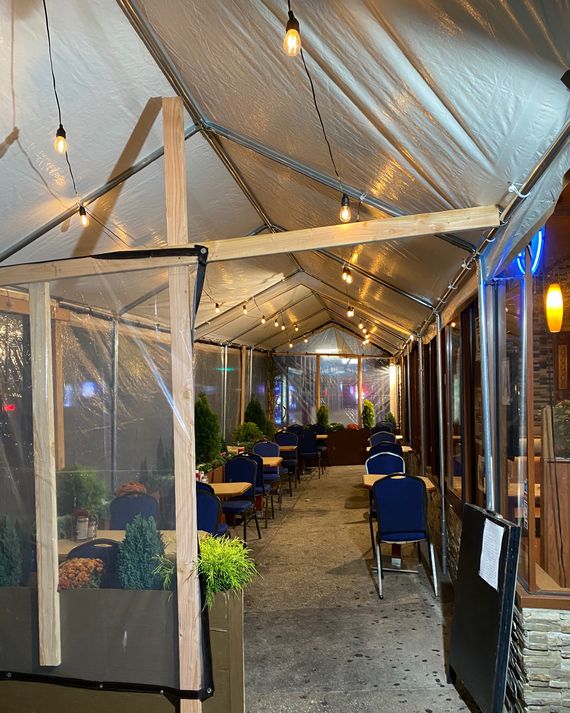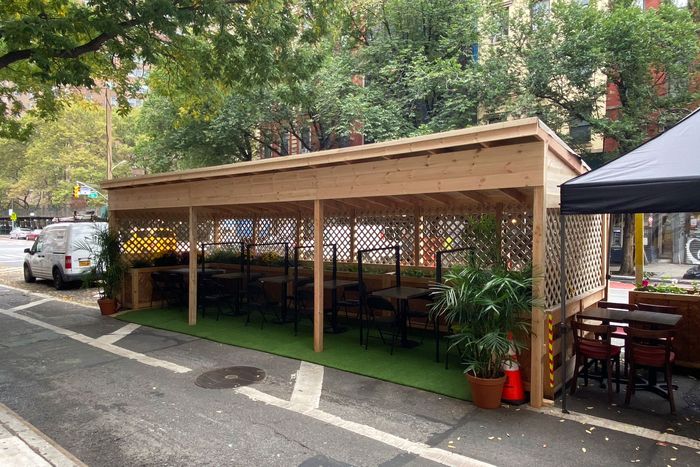
New York City restaurant owners are facing a new challenge — aside from, you know, keeping their businesses afloat and their customers safe. The question now is over how to keep serving diners outdoors when it’s freezing. Some have turned to plastic bubble tents as a solution, while others are now building more permanent cabin-like structures right on the sidewalk or street — some of which are so enclosed that they can barely be distinguished from the buildings they popped up alongside. The thriving (but controversial) streetery scene has made the COVID summer a far more exciting one for New Yorkers, and has helped countless restaurants stay afloat. As the fall chill arrives, the robustness of these quasi-cabins raises a question for concerned diners and restaurateurs: When is outdoor dining no longer outdoors?
And with temperatures dropping significantly in the coming months (and at least a few snowstorms on the horizon), will dining inside these cabins be New Yorkers’ only option for eating out? What’s street-side dining going to be like in an uninsulated plywood structure with a bunch of propane heat lamps burning? We’re already seeing cabins across the city, from Park Slope to the East Village, so it looks like we’ll find out soon enough. Wondering if they’re safe is just one of many questions we have.
What are these streetery cabins?
They’re usually framed in two-by-fours and sheathed in plywood, with vinyl sheeting over the windows and other openings. Yu Zhang, the owner of the dessert joint Jell & Chill, on East 7th Street in the East Village, designed his own structure based on a greenhouse, using lumber and clear sheets of polycarbonate for the walls and roof. The pink-floored structure, which matches Jell & Chill’s logo, cost him around $4,000 in materials and labor.
Astrinos Voumvourakis, the owner of Orion Diner on the corner of East 23rd Street and Second Avenue, says he put a lot of thought into the structure he set up. “I did my research, we tried to do the right thing, to keep everybody safe,” he says. He ordered some tents and then hired construction workers to build out the wooden structure with a tarp, some planters, and lights at the top — he says he hasn’t been billed for it yet, but he expects it to cost him between $5,000 and $6,000.
Prentiss Alter, who owns the vegetarian Divya’s Kitchen on First Avenue, built a breezy wooden structure — one that’s entirely open along the sidewalk — with lattice and separate sections divided with plexiglass. “We wanted to make it feel akin to the experience of the restaurant which has sort of this California natural aesthetic,” Alter says. “The idea was to kind of make it kind of feel like a gazebo.” The structure — which cost him about $10,000 — also includes green turf, glowing pendants, and planters.
Some of these seem like full-on buildings, though.
Two weeks ago, Peter Day decided to build a bulky, light-yellow structure on the sidewalk right outside the door of Love Mama, his East Village Thai restaurant. There’s a hydrant outside of his place, making roadway tables-and-chairs a no-go. Complete with vinyl windows, it’s almost like an extension of the restaurant itself. But since it was built without a permit, Day was given a Department of Buildings summons, and is now facing a fine of up to $12,500.
There are limitations to what you can build on the street, as Day’s cabin shows: Permits may be denied depending on the scope of a project; for instance, the city doesn’t allow for non-tent structures to be added to an existing building. But building cabin-like structures in the roadway as part of the city’s Open Restaurants program is very much allowed. Such structures, even if they’re fully enclosed, would have to meet the same standards as other streeteries, such as not blocking fire hydrants, crosswalks, and bike lanes.
So … isn’t that just indoor dining?
It depends on whether or not the structure is fully enclosed. To qualify as “outdoors,” a structure needs to be at least half open to the elements. Fully closed-off structures, even if they’re on the street, need to adhere to the same guidelines established for indoor dining, such as limiting seating to 25 percent of the standard capacity and conducting temperature checks. And, for instance, Love Mama’s bulky, building-adjacent structure is 100 percent enclosed.
The city will soon be releasing more detailed guidelines on “winterizing” outdoor dining structures, according to a spokesperson, including how to install heaters following Fire Department regulations.
Are these structures any more safe than restaurant interiors, then?
We know that ventilation is essential in even quasi-indoor spaces. So the safety of any given streetery cabin depends on its particulars — whether or not it’s open along the sidewalk, say, or if windows or other openings allow air to circulate. Fully enclosed cabins must follow the same regulations that apply to indoor dining — because with a roof, walls, and windows, you are inside — including proper sanitation and sanitizing, and social-distancing measures.
Is there a better way to build them?
Though some restaurant owners have built very sophisticated (not to mention safe and aesthetically pleasing) outdoor structures, many argue that the city could be doing more to help owners logistically and financially.
The architect Vishaan Chakrabarti wants the city to put out a preapproved plan for winterized streeteries, and give restaurants the materials to build them. He says the city could provide heavy-duty tarps and scaffolding (free of cost, ideally) along with instructions on how to assemble them into a plastic-wrapped structure. That way, owners wouldn’t have to spend their resources and could automatically get something that is already approved (and has been tested for good air circulation and COVID safety). “[There are] scaffolding contractors all over New York City — they build all the stuff on the sidewalks everywhere — so they could put these things up very quickly,” Chakrabarti says. “It’s very inexpensive. You’re using a technology that’s extremely well-known; the workers are there, there’s nothing to design, or draw, or commission.”
Meanwhile, Jing Liu, principal at architecture firm SO-IL, who has been helping Jackson Heights restaurateurs build their streeteries pro bono, says that the city could recycle plywood and leftover two-by-fours from the construction industry (which usually just sends extras to landfills) to build shared multi-restaurant cabins on each block. The idea, she says, would be that everyone needs these streeteries, and as they become more ubiquitous and expensive for restaurants to maintain, she says, “Why not think of it on the street scale? Because when each individual person is trying to do it, it becomes environmentally very taxing.”







